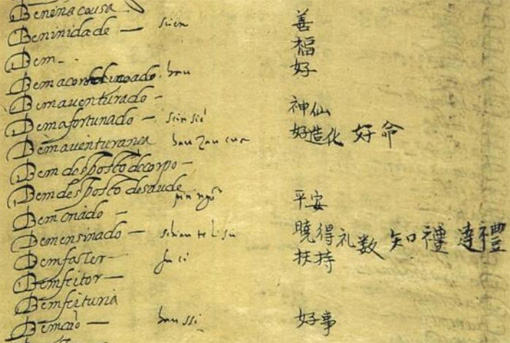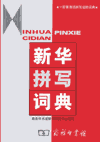
Here’s the first of several selected readings from Yin Binyong’s Xīnhuá Pīnxiě Cídiǎn (《新华拼写词典》 / 《新華拼寫詞典》). It covers the writing of verbs.
This reading is available in two versions:
For those who would like to read about this in English, see


Here’s the first of several selected readings from Yin Binyong’s Xīnhuá Pīnxiě Cídiǎn (《新华拼写词典》 / 《新華拼寫詞典》). It covers the writing of verbs.
This reading is available in two versions:
For those who would like to read about this in English, see
 Xīnhuá Pīnxiě Cídiǎn (《新华拼写词典》 / 《新華拼寫詞典》), is the second of Yin Binyong’s two books on Pinyin orthography. The first, Chinese Romanization: Pronunciation and Orthography, is in English and Mandarin; much of it is already available here on Pinyin.Info.
Xīnhuá Pīnxiě Cídiǎn (《新华拼写词典》 / 《新華拼寫詞典》), is the second of Yin Binyong’s two books on Pinyin orthography. The first, Chinese Romanization: Pronunciation and Orthography, is in English and Mandarin; much of it is already available here on Pinyin.Info.
Although Xinhua Pinxie Cidian is only in Mandarin, the large number of examples makes it easy to get the point even if you may not read Mandarin in Chinese characters very well.
This week I will begin posting some excerpts from this invaluable work. What’s more, I have made a version in traditional Chinese characters, which I hope that readers in Taiwan, Hong Kong, and elsewhere will take advantage of. So those not used to reading simplified Chinese characters will have a choice (which is more than the government of Taiwan is providing these days).
I’m extremely happy to be able to bring you this information and wish to acknowledge the generosity of the Commercial Press. Stay tuned.
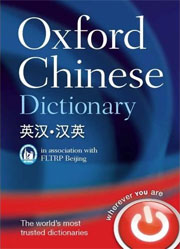 Oxford University Press has just announced that its massive Oxford Chinese Dictionary is now available through its Oxford Language Dictionaries Online subscription service.
Oxford University Press has just announced that its massive Oxford Chinese Dictionary is now available through its Oxford Language Dictionaries Online subscription service.
I haven’t seen the online version yet myself; but from the publisher’s description it appears to be largely the same as the published edition, whose paucity of Pinyin is disappointing. The publisher, however, is promising that “Pinyin will be added to all Chinese translations” in November, which should be a major step forward.
Perhaps some of you at universities have institutional access. I would welcome reports.
source: What’s New, Oxford Language Dictionaries Online, May 2011.
 One of my favorite programs, Wenlin (which bills itself as “software for learning Chinese”), has just released a major upgrade for both Mac and Windows versions. This doesn’t happen often; it has been three-and-a-half years since the most recent big change was issued (Wenlin 3.4) and heaven only knows how long since 3.0 came out. So, yes, this release has many substantial improvements.
One of my favorite programs, Wenlin (which bills itself as “software for learning Chinese”), has just released a major upgrade for both Mac and Windows versions. This doesn’t happen often; it has been three-and-a-half years since the most recent big change was issued (Wenlin 3.4) and heaven only knows how long since 3.0 came out. So, yes, this release has many substantial improvements.
One of the features nearest and dearest to my heart is that Wenlin 4.0 features greatly improved handling of Pinyin. I was among the field testers for the new version, so I’ve already spent a lot of time examining this feature. Here are a few important aspects of this:
There are, of course, many improvements beyond the area of Pinyin. Here are a few:
The full version (i.e., the CD with the program comes in a box and is likely packaged with a hard copy of the manual) is US$199, or US$179 if you download it from the Wenlin Web store. Upgrades from 3.x cost US$49.
For more information, see the summary of features and outline of what’s new in Wenlin 4.0.
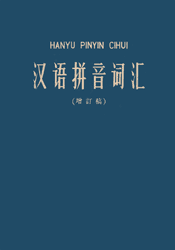 Today, for all you orthography junkies (Hello? Hello? Anybody there?), I have added a selection from the 1963 edition of Hanyu Pinyin Cihui (汉语拼音词汇 / Hànyǔ Pīnyīn Cíhuì).
Today, for all you orthography junkies (Hello? Hello? Anybody there?), I have added a selection from the 1963 edition of Hanyu Pinyin Cihui (汉语拼音词汇 / Hànyǔ Pīnyīn Cíhuì).
The book, which is fully alphabetized by Hanyu Pinyin (i.e., like the ABC dictionary series, not like the Hanzi-by-Hanzi Pinyin ordering seen in most dictionaries published in the PRC), is a long list of Mandarin words as written in Hanyu Pinyin and Chinese characters. It’s meant as a reference for word division and other such orthographic concerns. It’s the sort of thing that just cried out to have been made into a full dictionary (especially since that’s what it looks like, minus definitions); but, unfortunately, it never was. But it was an important influence on the ABC series.
One can see some interesting instances of differences between Pinyin orthography then and now. For example, in this old edition of Hanyu Pinyin Cihui de tends to be appended to words and written as d, e.g. ái’áid, rather than the current ái’ái de (皚皚的). Similarly, zi is written z at the end of a word, e.g. ǎigèz, rather than the current ǎigèzi (矮个子).
Also interesting is the mixed use of simplified and traditional Chinese characters. (It will be easier to see what I’m referring to if you open the PDF file of the introduction and A’s of Hanyu Pinyin Cihui.) The title on the cover is given as 汉语拼音词汇 in Chinese characters — perfectly standard. But below this is 增訂稿 (zēngdìng gǎo / revised edition); note how dìng is written as 訂 rather than as 订.
More striking, though, for the modern reader is the script in the foreword. Here, what was written 汉语拼音词汇 on the cover is written 汉語拼音詞汇, mixing traditional and simplified forms. The full traditional version of this would be written 漢語拼音詞彙. The text of the introduction is similarly mixed. This is because this was published before many simplified forms that are now standard were fully accepted officially.
The selection from this book here on Pinyin.info comprises the introduction and all of the entries beginning with the letter a.
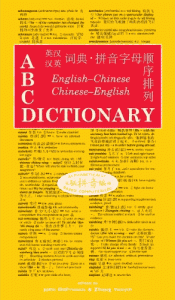 The ABC Chinese-English Dictionary was published ten years ago. It was revolutionary in that, for the first time, a Mandarin-English dictionary was ordered entirely by the headwords’ pronunciation as written in pinyin. (Stroke and radical indexes are also there to aid finding a character when its shape is known but not its pronunciation.) Other dictionaries in the DeFrancis ABC series have followed. But up to now there been no ABC dictionary with an English to Mandarin section as well as a Mandarin to English one.
The ABC Chinese-English Dictionary was published ten years ago. It was revolutionary in that, for the first time, a Mandarin-English dictionary was ordered entirely by the headwords’ pronunciation as written in pinyin. (Stroke and radical indexes are also there to aid finding a character when its shape is known but not its pronunciation.) Other dictionaries in the DeFrancis ABC series have followed. But up to now there been no ABC dictionary with an English to Mandarin section as well as a Mandarin to English one.
At the end of this month the University of Hawai`i Press is releasing the ABC English-Chinese, Chinese-English Dictionary. The new dictionary, which is 1,252 pages long, has 29,670 entries in its English-Mandarin section and 37,963 entries for Mandarin-English (total 67,633 entries). (The much larger ABC Chinese-English Comprehensive Dictionary has some 196,000 entries — all Mandarin-English).
This is a big year for Mandarin-English dictionaries, with the forthcoming release of the ABC ECCE and the release three months ago of the massive Oxford Chinese Dictionary. From the standpoint of Pinyin, however, the Oxford dictionary is a disappointment. For example, the Oxford dictionary has no Pinyin in the English-Mandarin section, just Chinese characters; in some other places tone marks are missing from some of the Pinyin, where it appears at all. Perhaps this will be rectified in the online edition, which has yet to appear. At the moment, though, the Oxford looks like a fairly traditional dictionary — albeit a huge one — aimed mainly at English learners in China, which isn’t necessarily a bad thing if you happen to be among that very large group of people. For more on the Oxford, see the video at Danwei and the entries at Chinese Forums (with some images) and Language Log.
Unlike the Oxford dictionary, the ABC ECCE offers both Pinyin and Chinese characters for all entries and sample sentences. (See samples below. Click on those for more extensive examples in PDF files.)
From what I’ve seen so far of the ABC English-Chinese, Chinese-English Dictionary, I expect it to become the dictionary for English-speaking students of Mandarin. I’ll write more about this once I’m able to see a hard copy.
The ABC English-Chinese, Chinese-English Dictionary retails for only US$20, compared to US$75 for the Oxford.
From the Mandarin-English section. But don’t expect the text in the printed edition to be this large. I’ve enlarged the image to make it easier to read on the Web.
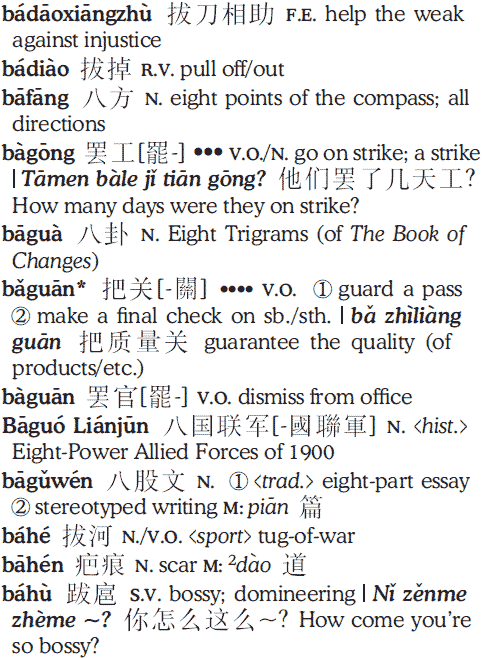
From the English-Mandarin section:
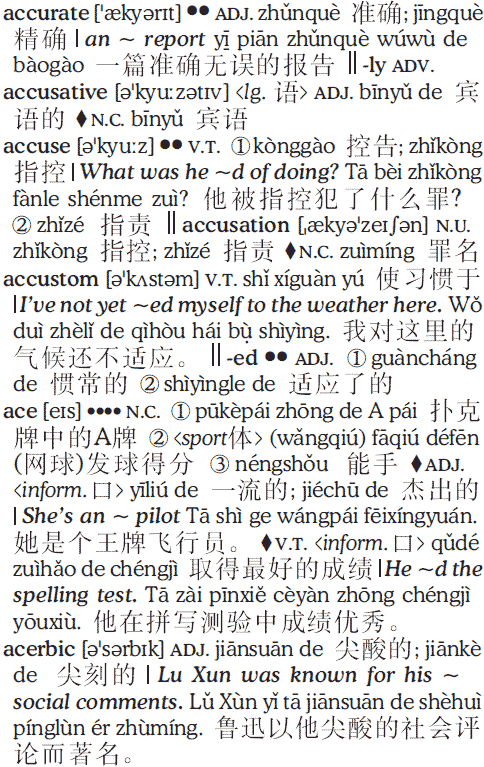
(ISBN-10: 0824834852; ISBN-13: 978-0824834852)
See also:
Maryknoll Language Service Center has put online the complete texts of its Taiwanese-English and English-Taiwanese dictionaries. Better still, these have been released under a Creative Commons license. These are a terrific resource for anyone who’s interested in Hoklo.
Maryknoll deserves praise for this great work. Thanks are due, too, to Tailingua, which I know has been working behind the scenes to help make this happen.
From the English Amoy Dictionary (英語閩南語字典):
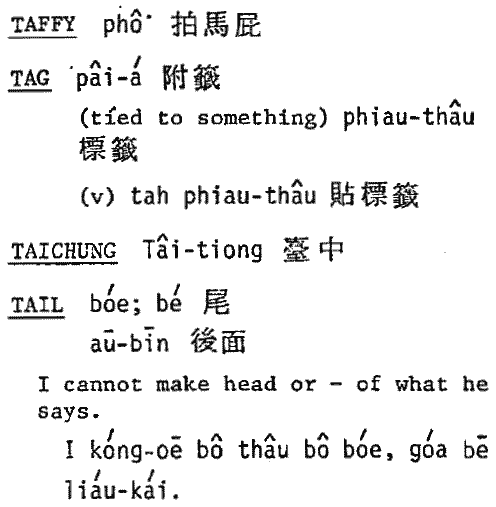
And from the Taiwanese-English Dictionary (台語英語字典):
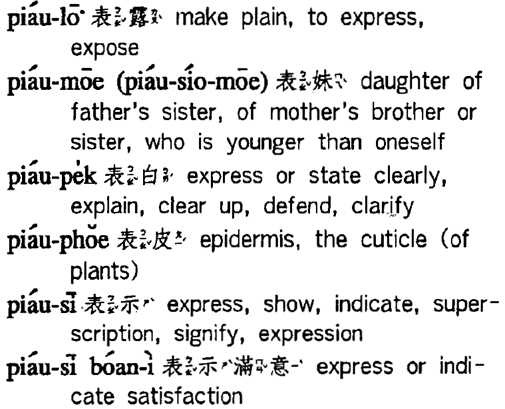
source: Maryknoll dictionaries now free to download, Tailingua, June 17, 2010
 The magnificent Grand dictionnaire Ricci de la langue chinoise, better known as le Grand Ricci, has just been released on DVD, almost a decade after its release in book form and exactly four hundred years after the death of Matteo Ricci.
The magnificent Grand dictionnaire Ricci de la langue chinoise, better known as le Grand Ricci, has just been released on DVD, almost a decade after its release in book form and exactly four hundred years after the death of Matteo Ricci.
The list price is 120 euros (about US$150), which is much cheaper than the printed edition. A long video in French (16:31) discusses the work. For those who would prefer something in English, a PDF gives background information on the dictionary project.
For a sample of the dictionary’s format and entries, see the 25 pages of entries for shan. Alas, as this example shows, the entries are not word parsed. But at least Hanyu Pinyin is now available for those who prefer it to Wade-Giles.
As long as I’m mentioning Ricci-related work, I might as well use the occasion to note that the Taipei Ricci Institute is putting its collection of books on permanent loan to Taiwan’s National Central Library.
Also, I’d like to note that parts of Matteo Ricci’s original dictionary can now be viewed through the Google Books scan of a publication from earlier this century of his Dicionário Português-Chinês.
Enjoy.
